Anne-Marie note: Elham sent me a baby care package months ago with a wonderful bar of beer soap. I couldn’t get over how nice it was in the shower with luxurious, soft lather that felt silky on the skin and rinsed away cleanly. She has graciously agreed to do a tutorial on this wonderful soap. Thank you Elham!
Hi, I’m Elham from SkinChakra® and I am so excited to be here for a guest post.
I have been a cosmetic chemist for almost half of my life, and I’ve had my own line of hand-crafted soap and skin care products for the past two years (in addition to my consulting activities in the cosmetic industry). I live in Bavaria in Germany, and so I have had the opportunity to experiment with countless beer soap variations. I am surrounded by small, handcrafted breweries, and I consider myself a specialist in beer soap. Not surprisingly, beer soap is one of my best selling products!

Today, I’ll show you how to make a marbled beer soap. I hope you enjoy this recipe! (Note from A-M: If you’ve never made Cold Process soap before, stop here! I highly recommend checking out our FREE four part SoapQueen.tv series on Cold Process Soapmaking, especially the episode on lye safety. And if you’d rather do some reading, Bramble Berry carries a wide range of books on the topic, including my newest book, Soap Crafting. You can also checkout the digital downloads for that instant gratification factor. — A-M.)
Notes from Elham before you begin:
1. The color of the soap depends on the beer and on the origin of all other oils. Lighter beers may cause slightly lighter colors while darker beers can cause more brownish colors. I’ve mainly applied virgin plant oils with intensive inherent colors, so the color of your oils might be different from mine. (Keep in mind that the color and even the scent of plant oils and essential oils differs from harvest to harvest and from batch to batch)
2. I understand that babassu oil is not available to most of you and that Bramble Berry doesn’t supply this oil at the moment. The only oil with exactly the same SAP value is palm kernel oil, and you can replace babassu with palm kernel oil in a 1:1 ration without running the whole calculation through the Lye Calculator. However, if you decide to replace it with any other oil, you have to recalculate the lye. I do not recommend increasing coconut oil, but you may replace babassu oil with each one of or a combination of : (perilla seed oil, rice bran oil, camelina seed oil, sesame oil, sweet almond oil etc.) I do not recommend applying cocoa butter in this recipe but you may apply shea butter, mango seed butter or partially hydrogenated soybean oil instead of babassu oil (don’t forget to run it through the lye calculator!)
3. I have not considered the superfat (soybean oil in my case) in the lye calculation. It means you can easily replace it with your preferred oil without any need to redo the lye calculation. I do not recommend green-colored oils in this recipe (Avocado, Tamanu or Hemp Seed Oil for example). My soybean is a virgin oil with a very intensive yellow color but it doesn’t affect the beer soap that much.
Beer preparation:
You need about two standard bottles of beer (12 oz. each, 24 oz. total). Our Bavarian bottles are bigger (500 ml or 16.9 oz) and I evaporated one bottle to about 1/3 of the original volume (5 oz or 150 ml). In this particular recipe, I knew I needed about 4.5 oz. of beer so I boiled much more than I needed to start with. (P.S. For more on preparing beer for soapmaking, check out a beer soap tutorial we did back in August. – A-M)
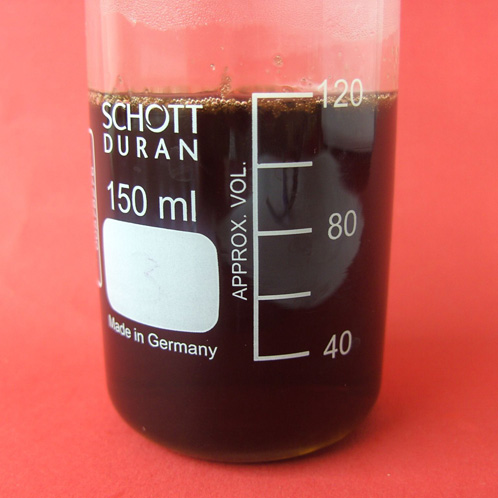
Before you begin, remember this important safety information:
Even if you are an experienced soapcrafter, it doesn’t hurt to review Anne-Marie’s fabulous video on lye safety or my blog post on safely handling sodium hydroxide. Remember: the most severe accidents tend be caused by experienced soapmakers and not beginners.
For this project you’ll need:
Chilled Beer (after evaporation): 4.6 oz
Cold distilled water: 4.6 oz
Sodium Hydroxide: 3.6 oz
Palm kernel oil: 20.0% (4.8 oz)
Palm oil: 15.0% (3.6 oz)
Coconut oil: 15.0% (3.6 oz)
Babassu oil: 5.0% (1.2 oz)
Rapeseed (Canola) oil: 20.0% (4.8 oz)
Sunflower oil: 20.0% (4.8 oz)
Castor oil: 5.0% (1.2 oz)
Soybean oil (superfat): 7.0 % (2.1 oz) based on oil content
Cedarwood Essential Oil: 2.5% (0.6 oz) based on oil content
2 lb. Wood Loaf Mold with Silicone Liner
SAFETY FIRST: Suit up for safe handling practices! That means goggles, gloves and long sleeves. Make sure kids, pets, and other distractions and tripping hazards are out of the house or don’t have access to your soaping space. Always soap in a well-ventilated area.
One: Prepare your lye solutions by slowly pouring the sodium hydroxide into the cold water and beer separately and stirring until the the lye has dissolved. (This means adding 1.8 oz lye to 4.6 oz water and 1.8 oz lye to 4.6 oz beer). The beer turns to an ugly dark color with a disgusting smell (don’t be disappointed, it is temporary). I prefer to keep my liquid pot in a cold water bath to better control and reduce the temperature of the lye water. If you’re working in a cold lab or soap kitchen you may rely on the room temperature to adjust the temperature.
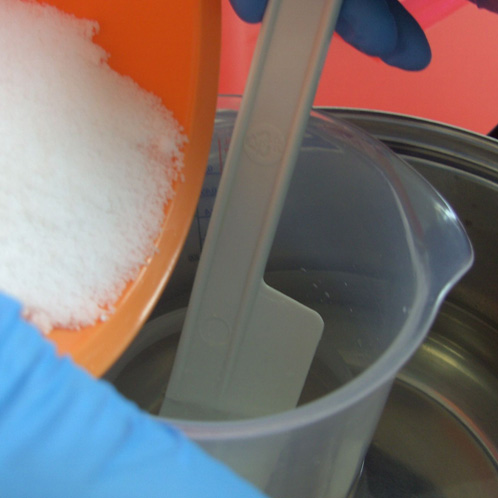
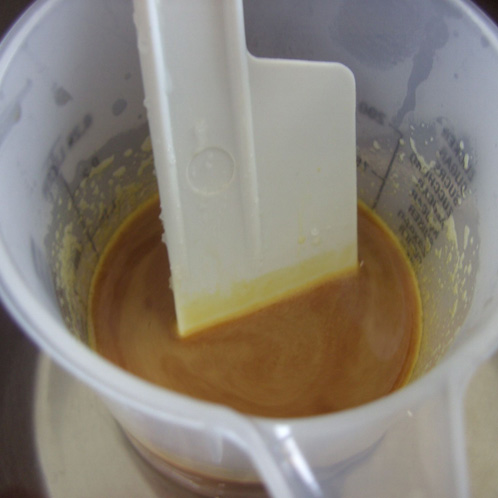
Two: As the lye solution becomes cold, melt your solid oils in a water bath. Do not let the water temperature exceed 170 degrees F.
Three: When the solid oils are melted, add the Babassu, Rapeseed, Sunflower and Castor oils and mix gently with a spatula. (Note: If you don’t have any Babassu oil, you can substitute more coconut oil in its place. If you use more coconut oil, you’ll need to run the recipe through Bramble Berry’s lye calculator to get the new amounts of lye and liquid).
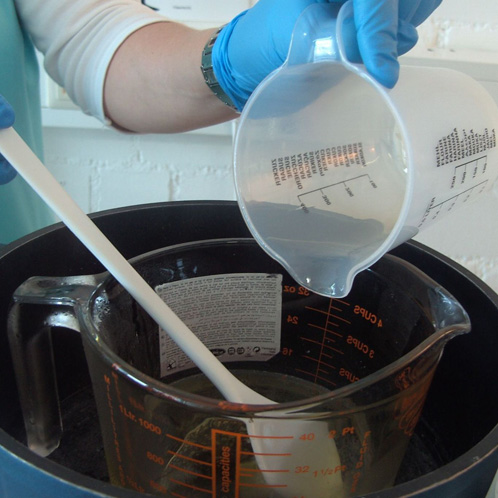
Four: Then combine the Soybean Oil and Cedarwood Essential Oil in a separate container. Mix well and then set aside for later.
Five: Measure the temperature of water-lye, beer-lye and the oil mixture. They should be around 100-120 degrees F with a max. of 10 degrees F difference between oil and lye as you mix lye and oil together.
Six: Divide your oil phase in two. Eyeballing is okay. If you’re working in a cold soap lab or kitchen, keep one part in the still-warm water bath to avoid cooling as you’re adding lye to the other part.
Seven: Gently tap your stick blender in the oil pot to get rid of air bubbles. Gently and slowly pour the lye (I prefer to start with the water-lye at first) over the blender. Turn the blender on and stir in short bursts. Avoid over mixing. You need a mixture with a thin trace. Keep in mind that this mixture doesn’t come to a heavy trace so don’t wait for it.
Eight: After you’re satisfied with the mixture, go to the second half of the oil blend and apply beer-lye over the stick blender and blend.
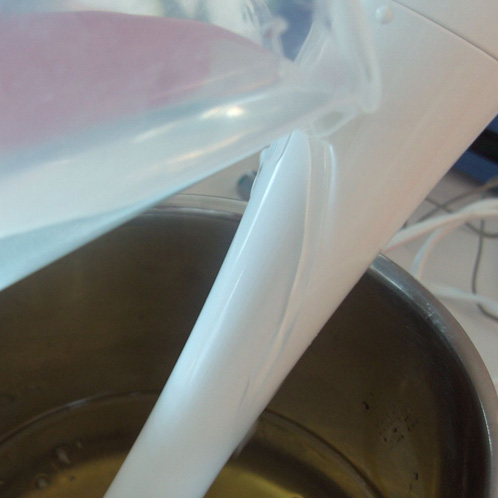
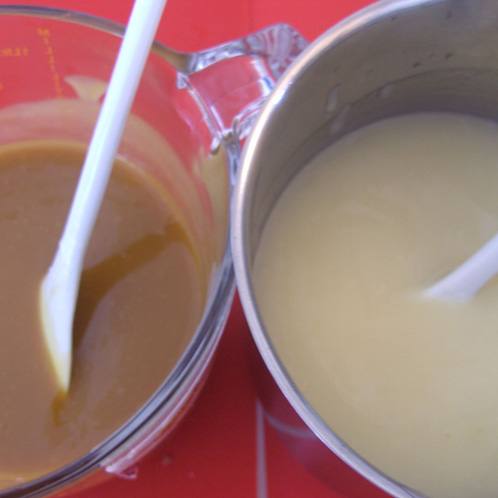
Nine: Apply the superfat and essential oil blend. Eyeballing is enough. Divide the mixture between two soap pots. Mix gently with a spatula.
Ten: The fun part begins from here. Alternate between pouring the dark soap and the light soap into the mold. There are no strict rules and there isn’t a ‘wrong’ way to do it! For this soap, I poured the batter from the middle of the mold, but you can try pouring from one side or one corner for different looks. Each time you marble, you’ll end up with a unique, beautiful result.

Pour both batters until you’ve poured all of the soap into the mold.
Eleven: Spray the surface with rubbing alcohol to avoid soda ash on the surface of the soap. As you see, I keep the surface rather rough. It’s up to you if you prefer a smooth surface or not.
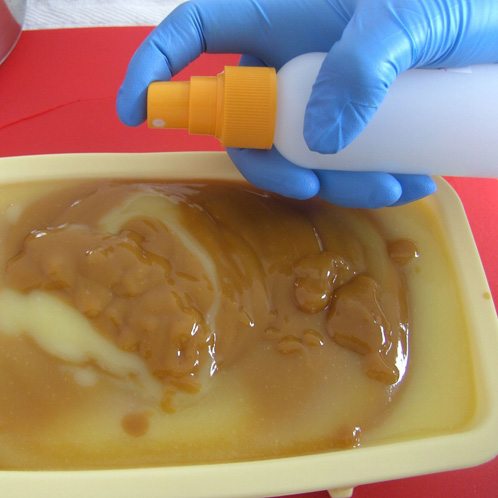
Twelve: We’re almost done now! Cover the mold and insulate the soap and keep it warm for at least 24 hours. I recommend waiting at least 48 hours before unmolding the soap.
As you can see, I like to use soap stamps in the finished bars. Then I set them on a curing rack and give them at least 8 weeks to fully cure.
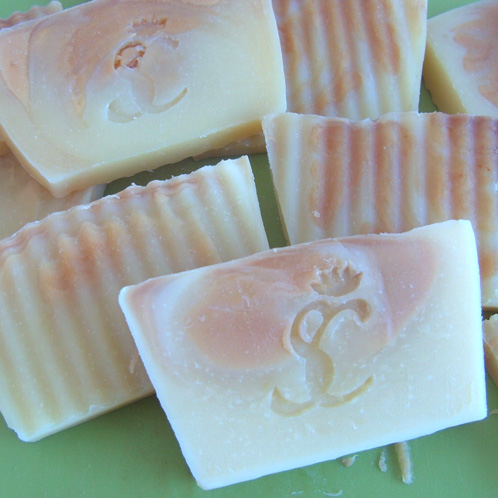
You’re welcome to visit my blog for other tutorials, and enjoy your beer soap! — Elham

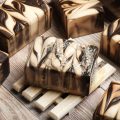
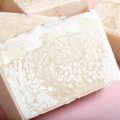

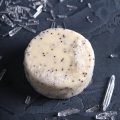
Hopefully not too many questions/comments:
1) I love beer soap recipes and am looking forward to trying this one. It has been fun to use home made Stout beer for my previous attempts, but I am running out of homemade beer that is allowed to be “sacrificed” for soap. Will lighter beers produce a lighter soap color, or do they all turn a dark brown in when adding lye?
2)Running this through the BB lye calculator, this recipe contains over 1 oz more of liquids that the calculator states (7.92 oz). I have found that using Palm Kernel Flakes always accelerates trace; is this extra liquid to give you more time to work with the soap?
3)Is there a step missing as far as taking half of the soap and lightening it with TD? (In the directions, after splitting the soap in half, one is magically lighter.)
4)Since Babassu Oil is known as being soothing, protective, conditioning and moisturizing to the skin, it would make sense to me to substitute it with something like Cocoa Butter which has natural antioxidants, moisturizing, rich in Vit E, etc. OR to use Avocado oil, Apricot Kernel oil, or Shea Butter, as they have some similar properties. (Of course I would run this through the lye calculator no matter what I use.)
Thank you again for the wonderful recipes!!
Hi Sly!
When making beer soaps, all beer is going to turn the soap a brownish color, but we do suggest experimenting with different kinds to see what works the best for you. Here are a couple of recipes we’ve used in the past with different kinds of beers, stouts and ales:
Bramble Beer Soap: http://www.soapqueen.com/bath-and-body-tutorials/cold-process-soap/bramble-beer-soap/
Last Call: Advanced Oatmeal Stout CP: http://www.soapqueen.com/bath-and-body-tutorials/cold-process-soap/last-call-advanced-oatmeal-stout-cp-2/
Soapfest 2011: Black and Tan Beer Soap: http://www.soapqueen.com/bath-and-body-tutorials/cold-process-soap/soapfest-2011-black-and-tan-beer-soap/
Luck of the Green Beer (CP tutorial): http://www.soapqueen.com/bath-and-body-tutorials/cold-process-soap/luck-of-the-green-beer-cp-tutorial/
The extra 1 ounce of liquid is something that Elham Eghbali (creator of this recipe) created. You would have to contact her to find out more information on why she included it!
I hope this helps! =)
-Becky with Bramble Berry
So you are saying that in the photo after step six, the almost white soap on the right is unscented beer soap and the brown soap on the left is brown because of the Cedarwood EO?
That makes no logical sense to me when beer turns soap brown and the Cedarwood EO BB sells does not discolor (or very minimally, according to the photo included with the info about the EO on the BB website) and soybean oil creates a white soap. Unless I’m missing something, I find that hard to believe and your info is misleading.
Hi Sly!
It looks at closer inspection that I may have misspoke. Since this is Elham’s recipe, we’d love for you to contact her as it is her recipe and we didn’t create it. She would be able to give you much better directions and explanation! You can find her blog here:
http://skinchakra.eu/blog/
If you make this recipe, we’d love to hear how it turns out for you. =)
Happy Soaping!
-Becky with Bramble Berry
It looks like the oil is split into two separate bowls at step 6, then you add water/lye mixture to half in step 7 and beer/lye to the other half in step 8 to get the lighter/darker mixtures.
Looks like a terrific recipe!
Thanks for the great post! And I’m having fun reading Elham’s blog posts auf Deutsch to practice my German vocabulary. 🙂
Beer soap is very high on my “to-do” list, and I’m curious how a beer shampoo would do. I have very fond memories of that shampoo “Body on Tap”, which I probably mainly loved because of its to-die-for fragrance (p.s. – if anyone knows of a similar fragrance out there, let me know!). Anyway, this post is encouraging me to give beer soap a try soon!
Daumen drücken (wish me luck)!
Hi Elizabeth!
We are so glad that you could enjoy this post and hope to see your beer soap soon on Bramble Berry’s Facebook page.
https://www.facebook.com/BrambleBerry
If you are interested in getting some fragrances that pair well with beer soaps, here are a few of our favorites:
Honey Ale Fragrance Oil: https://www.brambleberry.com/Honey-Ale-Fragrance-Oil-P4836.aspx
Oatmeal Stout Fragrance Oil: https://www.brambleberry.com/Oatmeal-Stout-Fragrance-Oil-P4838.aspx
Spiced Amber Ale Fragrance Oil: https://www.brambleberry.com/Spiced-Amber-Ale-Fragrance-Oil-P5670.aspx
Happy Soaping!
-Becky with Bramble Berry
Since the Soybean oil is just for superfat, can it be replaced with most any other liquid oil, if I do not have it on hand? Or do I need to put the whole thing through the lye calculator?
Hi ML,
Yes, you can replace the Soybean Oil with another carrier oil. I would not recommend using a hard oil such as a coconut or palm oil, but something like Rice Bran, Sunflower or Apricot Kernel.
Rice Bran: https://www.brambleberry.com/Rice-Bran-Oil-P4971.aspx
Sunflower: https://www.brambleberry.com/Sunflower-Oil-P3208.aspx
Apricot Kernel: https://www.brambleberry.com/Apricot-Kernel-Oil-P3206.aspx
This recipe is a little unusual for us as we typically use our lye calculator to pick the superfat and it is built into any of our tutorials. If you changed the Soybean Oil, you wouldn’t actually have to run the entire recipe through the lye calculator again.
Lye Calculator: https://www.brambleberry.com/Pages/Lye-Calculator.aspx
I hope that this helps!
-Becky with Bramble Berry
This looks interesting and I’m excited to try it. Any good suppliers for babassu oil? We have been experimenting with beer, wine, and mead soap, but they have a tendency to trace very quickly. Last batch of wine soap set so fast that we ended up rebatching in a crock-pot, thanks AM! That one was a little volatile with the lye water. Thinking it might be alcohol/sugar related we have made sure to boil off, cool, even freeze. The mead soap we did similar to AM’s goats milk tutorial. All was going perfect, about 120 degrees until that non-BB pear fragrance oil. I almost had a large mead bar shaped like the bucket we were mixing it in. We quickly got it into the mold, then the temp shot up to 165 and became very oily on top. We have a local shop that would carry this soap and I am determined to get the mead right. The mead we are using is crisp with notes of pear and vanilla. Will be using only BB FO next time. Any thoughts???
Hello Brenda & Art!
Currently we don’t supply Babassu Oil, but you could check out your local natural health food store to see if they carry any or know anyone that does.
Sometimes wines and meads can have a bit of sugar in them that can cause the soap to overheat when working with it. Make sure to boil the alcohol out of it and prepare to move fast!
It could have also been the fragrance you were working with, you will always want to check those product notes! 🙂
-Becky with Bramble Berry
Thank you for the wonderful tutorial, Elham! All ingredients are on hand, besides the great fresh German beer :))
Hi Veronika!
We are so glad you got a chance to check out this tutorial and can’t wait for you to try it out. =)
Happy Soaping!
-Becky with Bramble Berry